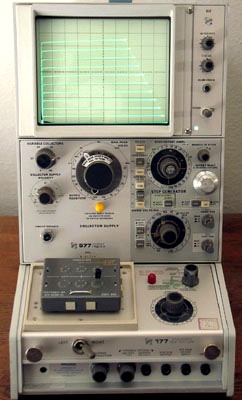
|
|
The Tektronix 577/177 is a non-programmable Curve Tracer System consits of a 577 Curve-Tracer Mainframe and a 177 Test Fixture. It is designed for testing semiconductor devices at power levels up to 100 Watts. Maximum continuous current is 10 amps (20 amps in pulsed mode). The 577's storage CRT may be used to overlay the characteristic curves of one device on top of the stored characteristics of another. Dot displays (generated during high-current pulsed testing or during very low-current testing under dc condItions) can be transformed into complete characteristic curves by simply moving them across the CRT while in the storage mode. Collector Supply Modes/Polarity: Norm; AC (at line frequency); positive or negative full-wave rectified ac. DC: Positive or negative dc. Collector Supply Voltage 6.5V (10A cont.) to 1600V (0.04A cont.). Collector Supply Series Resistance: From 0.12 ohm to 8 Mohm in 14 steps, all within 15%, ±0.1 ohm. Peak Power Limit Setting: 100, 30, 9, 2.3, 0.6, and 0.15 W. Step Generator Current Mode:Step/Offset Amplitude Range: 5 nA/step (with X0.1 Mult) to 200 rnA/step, 1-2-5 sequence. Maximum Current (Steps and Aiding Offset): X20 amplitude setting, except X10 (2A) at 200 rnA/step and X15 (1.5 A) at 100 rnA/step. Maximum Voltage (Steps and Aiding Offset): At least 7 V. Maximum Opposing Offset Current: X10 amplitude setting or 10 rnA, whichever is less. Maximum opposing voltage is limited at 1 to 5 V. Step Generator Voltage Mode: Step/Offset Amplitude Range: 5 mV/step (with X0.1 Mult) to 2 V/step, 1-2-5 sequence. Maximum Voltage (Steps and Aiding Offset): 20 times amplitude-switch setting. Maximum Current: At least 100 rnA at 0 V. Short-Circuit Current Limiting: Not more than 200 rnA. Maximum Opposing Offset Voltage: X10 amplitude-switch setting. Maximum Opposing Current: Limited between 10 and 20 rnA (derating to 0 rnA at 20 V). Step Generator Accuracy Incremental: Within 2% between steps. Absolute: Within 3% of total output or amplitude setting, whichever is greater. Within 4% with X0.01 mult. Offset Multiplier: Continuously variable from 0 to X10 the amplitude setting, either aiding or opposing the step polarity. Vertical-Deflection Factor: Collector Current: 2 nA to 2 A/div, 28 steps in 1-2-5 sequence (0.2 nA to 0.2 A/div with X10 magnification). Horizontal-Deflection Factor: Collector Volts: 50 mV to 200 V/div, 12 steps in 1-2-5 sequence (5 mV to 20 V/div with X10 magnification). Base Volts: - 50 mV to 2 V/div, 6 steps in 1-2-5 sequence (5 mV to 0.2 V/div with X10 magnification). Step Generator: 1 step/div (0.1 step/div with X10 magnification).
|